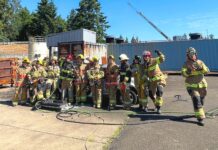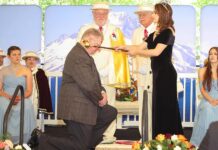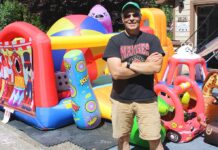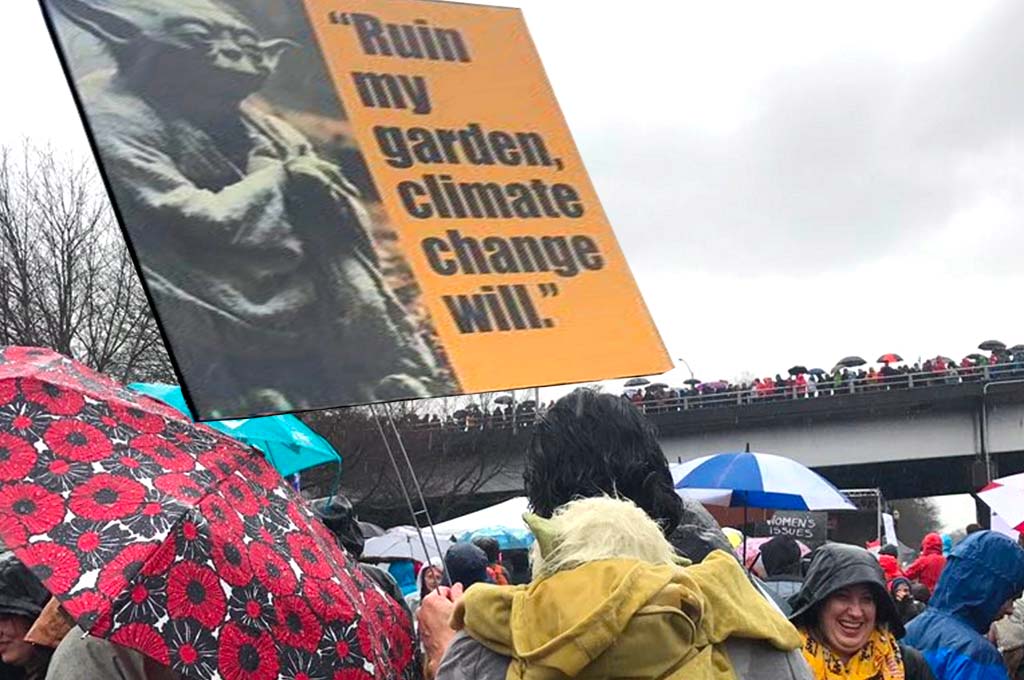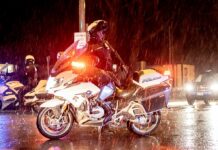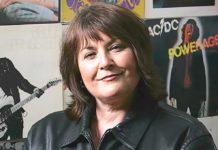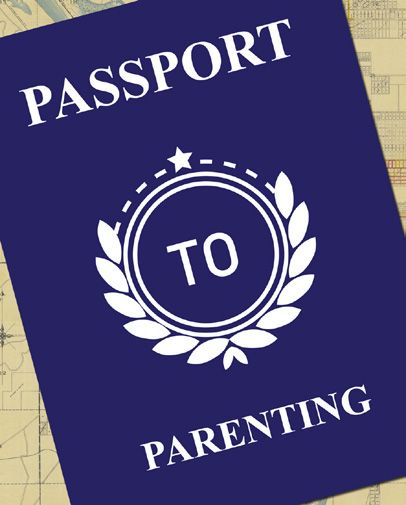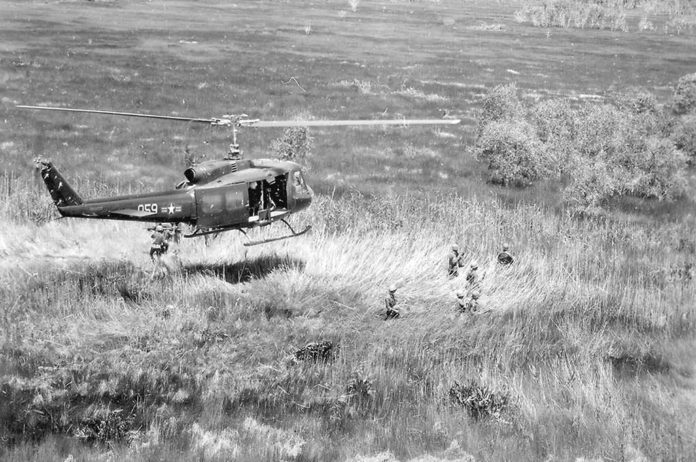
Before moving to Tualatin, Hal Long joined Marines to get GI Bill benefits for college, did three Vietnam tours for 18 months of combat; Health affected by Agent Orange
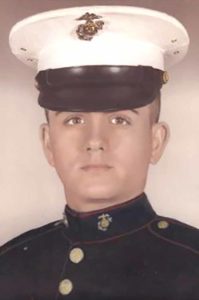
Harold R. “Hal” Long, who served three tours as a Marine in Vietnam, was known as a talented writer and play director when he lived in Tualatin. Those who worked with him knew he was blind but few knew his condition was caused by Agent Orange from when he was in-country.
Hal grew up in a tough town, Detroit. He joined the military before finishing high school. He figured he needed to get out of the Detroit flow before he got into trouble. He had some minor delinquency in his youth but decided on the Marines after being advised he needed to learn discipline. He had enjoyed John Wayne WWII movies; John Wayne on Wake Island, John Wayne in the Philippines, John Wayne with the Flying Tigers and envisioned himself in those roles – being a hero wasn’t too bad. But the main selling point was the GI bill, getting one year of college money for every year served. In 1959, he signed up for two years in the Marines. His service time was uneventful but he did earn his high school diploma. He then completed two years of college but found continuing school to be very expensive.
Hal bounced around on several different jobs until recruited in 1963 to re-enlist in the Marines for three years and more college money. This time he received intensive combat training. It included a 27-day trek with full gear, i.e a heavy backpack, walking through Death Valley and then scaling the heights of Mount Whitney, the most strenuous accomplishment in his life. He sailed to Vietnam, along with 2700 other Marines, on a troop transport ship that took 37 days. As he recalls, he was seasick, unable to keep food down so spent most of the trip with his head hanging over the side of the ship. Upon arrival, they were assigned as advisers in the Mekong Delta, into four-man teams doing reconnaissance – checking and reporting enemy activity to the South Vietnamese Army, often doing observation from trees. Guns were issued but no bullets. After losing 12 men the first day, ammunition was provided but only for defensive purposes! The Marines found their weapons were not made for jungle warfare – too big and too heavy. Their helmets were too heavy and flack jackets worthless. They discarded every thing they could. After about a week, Hal’s team discovered a cache of Czechoslovakian grease guns which were light and short, much more maneuverable.
Hal described the Mekong Delta as the liquefied portion of Vietnam – rice paddies, very soft earth, a mountainous area, extremely humid with little beasties that clung to you wherever you went. He claimed it was so humid, he could watch rust form on the barrel of his weapon. For the first three months, his team was in the open field where they were provided K-rations. a carryover from WWII. C-rations might have been good at the time for those who received them, but Hal’s team got old crackers and ham and lima beans in tins that Hal felt were probably canned in the ‘40s. Fortunately, their training included how to eat from the land. They knew the topography of the country and what foods grew wild and what were edible, so ate off the jungle.
Hal’s team worked hard to not be discovered while doing reconnaissance. They wanted to stay out of sight. As soon as their location was determined, they were certain to draw enemy fire. They kept moving but drew enemy fire every day, day after day. The constant danger developed into a form of fear. Concern for the people around you. The brotherhood of the three men you worked with in four-man team. Hal said the team was his existence. They were the life, they were the reason he was there. They were the reason he did what he was called to do. The idea was, “This is my brother and I am going to get him through it and he’s going to get me through it. We all survived because we became good at hiding.” Hal maintained contact with the other three of that four-man team after Vietnam. He said “we often jokingly refer to ‘living in the trees’ during that first 18 months.”
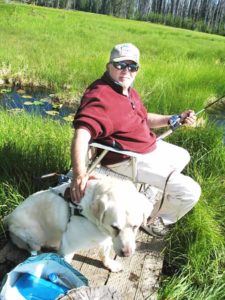
Hal said he had no contact with home during his first Vietnam tour. His Commanding Officer in Vietnam ordered everyone to write home so their family would know they were okay. They were not allowed to give any details about what they were doing, just that they were okay. He did write but when he came home on leave, his parents said they had not heard from him for three years. His trip home was disappointing. It infuriated him to see people walking down the street with their heads bobbing up and down. They weren’t marching in step. His former friends were still “growing up.” They didn’t look at the world as he looked at it. They did not understand what was going on in Vietnam because information at that time was very classified. “The motions we made, the maneuvers that we did, the missions we were required to do were only part of our military record and not known by the world.”
Our soldiers found the enemy to be highly organized, well trained and very motivated in what they were doing. The Vietnamese had been in constant battle status since 1945, with the anti-colonial war against the French and then the war of national reunification between the North and South. One of the major problems for Americans was identification. Hal had a total of 18 months of pure combat in his last three tours and never saw an enemy uniform. He said what he saw (to him) “looked like little people in black pajamas with straw hats and you never knew whether they were with you or against you.”
Hal Long’s second tour in Vietnam brought him back to the Mekong Delta, First was as an advisor, this time the United States was officially at war
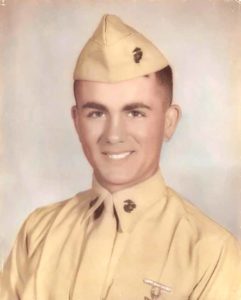
Harold R “Hal” Long had the same motivation to sign up for his second tour in Vietnam as his first enlistment; to get a college education. He had initially enlisted in the US Marine Corps for two years in 1959, while still in high school in Detroit; getting out of a tough town where it was easy to get in trouble. That service time was uneventful but he did earn a high school diploma. He got two years of college through the GI bill but was unable to continue because of the cost. In 1963. he was recruited to sign up three more years. He received intense combat training and spent his last 18 months in the Mekong Delta in the Southeast part of Vietnam as a member of a four-man reconnaissance team, reporting enemy activity to the South Vietnamese Army. That was a very dangerous job but Hal and his team survived. He kept in touch with them after the war. But in his second Vietnam tour two team members were killed. An adjoining company had received small fire from a small village near Da Nang. His team was assigned to go in and “clear it out.” He said dealing with civilians was always difficult because you never knew who they were. They did not find anything in the village to indicate the Viet Cong had ever been there. But as they were leaving the village, two men were shot in the back. Both died. “We didn’t wear flak jackets at that time. It was too cumbersome. You created such an easy target wearing an eight pound flak jacket that no one wore them. We never did find out who fired the shots.” Hal explained that his team members were highly trained in medical care but could not save their team members. “ We carried them out and they were buried in Da Nang.” At that time, bodies were not flown back home to the United States. Because of the tremendous heat, the bodies deteriorated very quickly. So burying them as fast as possible was important. Getting replacements for the team members was very selective. They wanted soldiers with jungle experience. Hal said they trusted no one who didn’t have jungle experience, who were skilled and knew how to live from sunlight to sunset.
Hal’s orders for his second Vietnam tour had returned him back to the Mekong Delta, an area where he had become an expert, to Echo Company, 2nd Battalion, 5th Marine Regiment, 1st Marine Division. He was attached as a reconnaissance point man for Echo Company. By then he was a Sergeant. Hal said there were 150,000 more American soldiers there than before as the war buildup continued. Marine Corps then broke down into four-man fire teams — a rifleman, assistant rifleman, a Brownie Automatic (BAR) man and a munitions man. This was the heart of the Marine Corps operation. Each squad had three fire teams, for a total of 12 men. There are three squads to a company. Each battalion consisted of four companies, 146 men. These teams could act on a small basis or function as a group. Hal said that communication in the field in Vietnam was very good with short wave radios. They were PRC-6’s, which were a very light duty, short range radio. Hal wondered why the Vietnamese never mastered that radio system. That befuddled him because they were so brilliant at every other thing.
Hal said the Vietnamese had several advantages. One was their proficiency at digging tunnels. Those tunnels would go underground for miles. He said our troops could not figure out how the Vietnamese could move from place to place so quickly without being seen. They could move much faster because they were unobstructed. That was one factor that brought helicopters into the war, they could rapidly transport soldiers. One of the major difficulties was that our troops were still using World War 11 techniques, fighting in mass combat with big units. He said the Marines were the first service who broke away from the WWII open trench warfare to a new type that meant we had to be very mobile. We had to move quickly. Having a helicopter swoop in, pick up 12 guys, fly three miles, and get close enough to the ground to allow those guys to jump out was a method that we perfected and it became very proficient for the rest of the war. He said “to fight the Vietnamese they studied the techniques used by the Southern soldiers in the Civil War who fought with delaying-action tactics. They never faced the enemy unless they knew they had superior forces. They never fought unless they knew they could win.”
Focus on combat was something he had a concern about today’s soldiers. They have the ability for regular communication with loved ones at home on a daily basis. That has to be a detriment to their focus which should be about staying alive for another day. According to Hal, with focus on combat, you never knew what day it was. In the field you lost track of birthdays and holidays. You knew the time of year because they had monsoons. He said “No one should ever complain about rain in the Portland area, they had rain that lasted literally, for months.” Often you could be staying in an underground bunker, something called a hooch which were sand bags with dug out holes under the ground to protect you from mortars. The Vietnamese did not have an Air Force. They never had big artillery but Hal said they could use small weapon better than any group of people he had ever seen or training against. Their use of mortars was outstanding. They could throw a 1,000 pounds into a camp before you could find where the rockets had been fired from. By that time, they’d be long gone. Communication in the field with your unit was very good with short wave radios. They were PRC-6’s, which were a very light duty, short range radio. Hal wondered why the Vietnamese never mastered that radio system. That befuddled him because they were so brilliant at every other thing.
The promise that he could attend the college of his choice was the incentive that motivated Hal Long to sign up for his third Vietnam tour, this time for one year. The Marines said they could not afford to lose his experience in the field. And he knew he could not afford more college without the GI Bill. His dream was to attend University of Michigan – he said “there is nobody from my block in Detroit who went to the Univ of Michigan and I wanted to be the first one.” He remained in the same unit, Echo Company, 2nd battalion, 5th Marines Regiment. 1st Marine Division.
His first assignment was with a group training Montagnard’s who lived in the mountainous area in Northern Vietnam, near the Laotian border. Being isolated, they had developed a different culture than the rest of Vietnam. They were fierce warriors and hated the Viet Minh (Viet Cong) Communists. He said his team quickly learned that the Montagnard’s “ needed no training what-so-ever. We learned so much from them; escape maneuvers that we never had thought of and fighting techniques that were ancient” He related them to American Indians. “They were so geared to natural movements that it was outstanding” He gave an example. We made a line about 50 feet long, reaching out by stretching out our arms. “Here we are, seasoned professional soldiers. Every single Montagnard made it by us and we had no idea they had ever been there. An impossible feat! An impossible feat! They went through us like we weren’t there. Working with Montagnard’s was a tremendous experience. They loved Americans. They loved the idea of freedom. Freedom was what they wanted more than anything.”
His next assignment was down in the valley to the city of Hue, a few weeks before the start of the Tet Offensive. For his first two weeks, there were no battle sounds, no rockets or mortar. “We thought that the Viet Cong had given up and were on their way back home.” Then the unified efforts of 400,000 Vietnamese overwhelmed the city. “We were caught off guard everywhere. We were forced to fight door-to-door in a city where the bad guys know where everything is and we don’t”. We had tremendous casualties. Some from their ability to booby trap bodies. Also in battle they fired to wound a soldier. So when others came to help him, they had more targets.”
Hal was air-evac-ed out three weeks into the Battle of Hue. He had shrapnel in his legs and back but the main reason was because he was getting sick. He thought that perhaps that long tours in Vietnam had caught up with him. It would be years before he found out why. There had been a time when he was under Agent Orange. “We were told it was a defoliant. Two hours after hitting the ground, it could take out an entire forest, every bug and every leaf. The enemy were so good at hiding, we could never find them. Agent Orange did bleach the land but they were underground so we still couldn’t find them.” He remembers standing, watching it come down and thinking “Wow, this is just like ash. It’s kind of pretty. Didn’t realize that if it was so good at killing things, what is it was doing to me.” After discharged, he developed diabetes that led to blindness. He says it took 35 years before VA concluded that Agent Orange had caused those.
At the University of Michigan, he asked “what can I make the most money at.“ When told it was Mechanical Engineering, he graduated with that degree and worked in that field for 35 years. He returned to Detroit after graduating. By then he was married with two kids. At the time, Detroit was the “murder capital of the world”. With the life there, “one of my kids would end up in jail and the other shot in the streets. I couldn’t have that so sold the house. My wife, kids and I headed our car westward, thinking wherever we stop has to better than Detroit.” They stopped in the Dakota’s for a few days where Hal thought about becoming a Park Ranger. When told about 12 feet of snow in the winter, he decided best to continue West. Said he drove until he physically couldn’t drive anymore, ending up in the parking lot of the Newbe)rg, OR Thriftway Store. In settling there, he looked for the biggest ad in the phone book for mechanical engineering. It was Swan-Wooster in downtown Portland who hired him after he said he would give them eight hours a day of good honest work and would never cheat or disrespect them. Among other projects there, he helped develop the first composting system in Oregon, for city of Portland. He also designed mechanical systems at (the) Hanford Site, a decommissioned nuclear facility. His last engineering job was in Weed, CA, where he developed a plant to use waste fuel products to provide electricity for Roseburg Lumber
In Tualatin, he was best known for writing and directing plays. He directed ten plays in two and half seasons before moving to Joseph where he developed another group of Players.. One of the last plays Hal wrote made it to the Regionals for the 2013 State Acting Festival “The Legend of Jimmy Blue Eyes”. Many of the plays he wrote had military themes. One of the most popular was “North Platte Canteen, about a community that provided refreshments and hospitality to soldiers during their ten-to-fifteen minute stopovers there while traveling on the Union Pacific Railroad on their way to war. Over six million soldiers were served. The play’s cast traveled by train to North Platte for their last performance. Hal and Lynn moved to Joseph in 2008. The last play he finished was “Soldiers Heart”, a sequel to “North Platte Canteen”, and a commentary on how what we now call PTSD was treated in WWII. The performers in Joseph broke out in applause when they finished reading “Heart.” Overall, Hal wrote seven plays, most while living in Tualatin. He also was on the writing team for George Clooney’s re-make of “Fail Safe”, a made for TV, Emmy-award winning movie.
Note: The information in this column came from an 2007 interview of Hal Long by Larry McClure for a Tualatin Historical Society project. Hal’s wife, Lynn Wolf, also contributed. Hal lived in Tualatin from 2001 to 2008 and passed away on July 19, 2015.

